Choosing the right paint color for your space is more than just picking a shade you like; it’s about setting the tone for your room and bringing your style to life.
SW 7042, commonly known as Shoji White by Sherwin Williams, is a timeless and versatile hue that offers a fresh and airy feel to any space it graces.
This particular shade of white has a soft warmth to it, making it perfect for creating a cozy yet bright atmosphere in your home.
Shoji White stands out for its ability to blend seamlessly with various decor styles and color palettes. Whether you’re giving a modern touch to your living room, adding a serene vibe to your bedroom, or making your kitchen feel more inviting, this color has got you covered.
It’s not just a simple white; it has depth and subtlety that can transform a space without overwhelming it.
If you’re on the hunt for a color that will complement your furniture, artwork, and personal style, while also making your home feel open and light, Shoji White is worth considering.
In the following sections, we’ll explore how this paint can enhance different rooms, its compatibility with other colors, and some tips for getting the best results.
This guide aims to help you make an informed decision in your home renovation or redecoration project, ensuring that Shoji White works perfectly for you.
What Color Is Shoji White SW 7042 by Sherwin Williams?
Shoji White by Sherwin Williams is a soft, warm white with a hint of greige, offering a cozy and inviting ambiance.
This versatile shade balances between white and beige, making it an ideal choice for those looking to add warmth to their spaces without overpowering them with color. It shines in natural light, bringing out a subtle depth that can make rooms feel more spacious and airy.
This color works exceptionally well in a variety of interior styles, from modern and minimalist to rustic and farmhouse. Shoji White can create a smooth, serene backdrop for contemporary spaces, highlighting sleek furniture and bold accent pieces.
In more traditional or rustic settings, it complements natural wood, adding to the room’s warmth and character.
Shoji White pairs beautifully with a wide range of materials and textures. It looks stunning against rich woods, enhancing their natural beauty and bringing a sense of harmony to the space.
Metals, whether brushed nickel, polished brass, or matte black, pop against this backdrop, adding a touch of luxury or industrial edge.
For textures, it supports both soft fabrics and rougher materials like jute or wool, allowing for a layered, tactile interior that invites you to relax and feel at home.
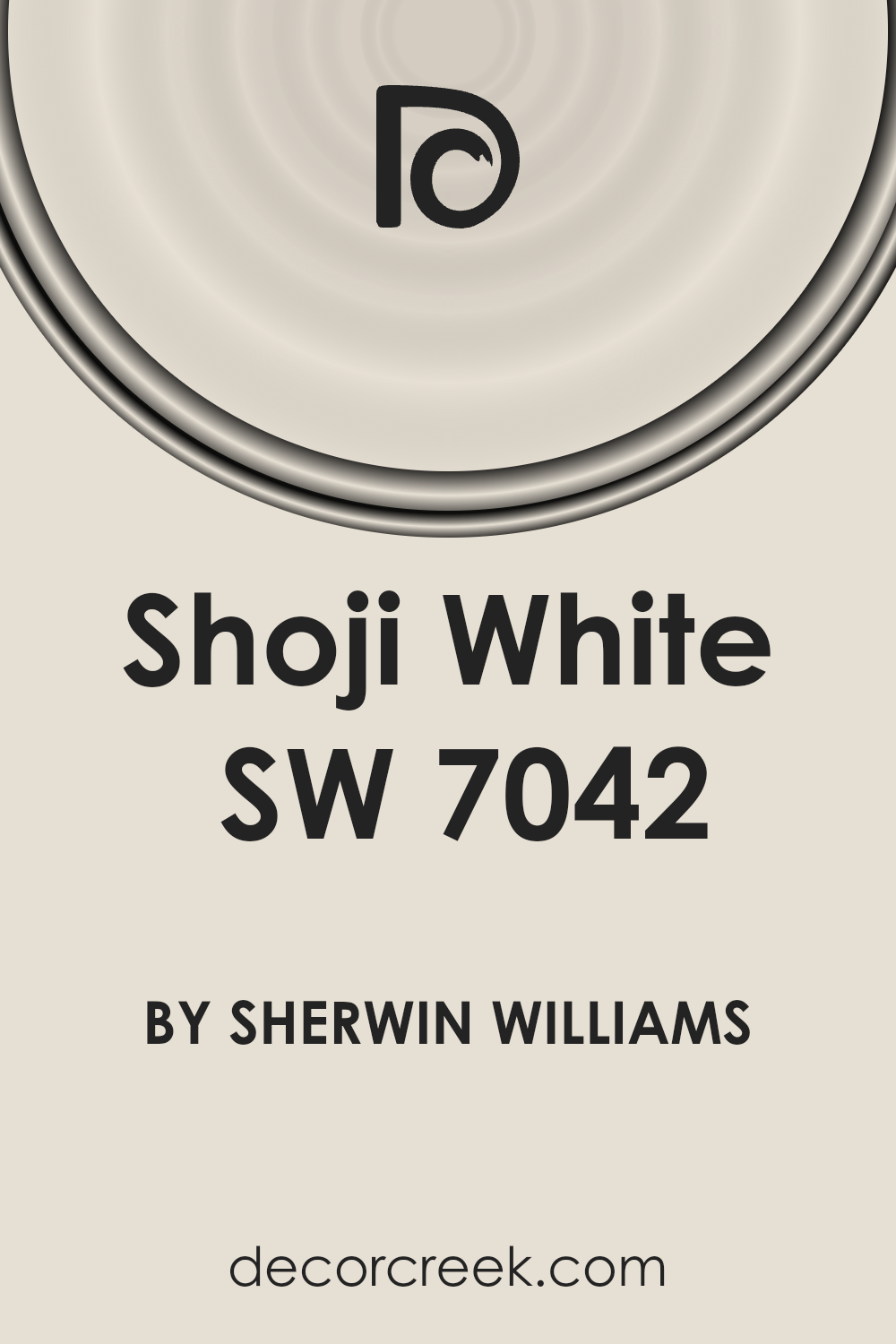
Ever wished paint sampling was as easy as sticking a sticker? Guess what? Now it is! Discover Samplize's unique Peel & Stick samples.
Get paint samples
Is Shoji White SW 7042 by Sherwin Williams Warm or Cool color?
Shoji White by Sherwin Williams is a versatile paint color that transforms any room into a peaceful and welcoming space. This shade is a soft white with warm undertones, making it perfect for creating a cozy atmosphere without feeling too stark or cold.
What’s great about Shoji White is how it adapts to different lighting conditions. In rooms with plenty of natural light, it can appear brighter, enhancing the airy feel of the space.
In spaces with less light, its warm undertones come to the forefront, adding a subtle depth that prevents the room from feeling flat.
This adaptability makes Shoji White an excellent choice for any area of your home, from the living room to the bedroom. It pairs beautifully with a wide range of décor styles and colors, serving as a neutral backdrop that allows your furniture and art to take center stage.
Whether you’re aiming for a minimalist look or something more eclectic, Shoji White creates a calm and inviting canvas that elevates your home’s aesthetic. Its ability to blend seamlessly with other hues and elements is why many homeowners favor it for their walls.
Undertones of Shoji White SW 7042 by Sherwin Williams
Shoji White has a beautiful, subtle base that can really change the vibe of a room depending on the light and surrounding colors. This color isn’t just simple white; it carries undertones of pale yellow and light purple, which add depth and complexity to its appearance.
Understanding undertones is essential because they influence how we perceive color. They can make a color feel warmer, cooler, or give it a unique character.
The pale yellow undertone in Shoji White adds a touch of warmth, making spaces feel more inviting and cozy. It’s like a soft hug for your room, creating a comforting ambiance.
This warmth is especially appreciated in rooms that don’t get a lot of natural sunlight, as it can help counteract the lack of light with a gentle, sunny glow.
On the other hand, the light purple undertone introduces a hint of coolness and sophistication.
This subtle touch can add an unexpected but pleasant nuance to a space, especially in well-lit areas where the natural light can play off this undertone, highlighting it in a very soft and delicate way.
When Shoji White is used on interior walls, these undertones work together to create a versatile backdrop that can complement both warm and cool tones in your furniture and decor.
This makes it a fantastic choice for creating a balanced, harmonious look in your home. Whether you’re going for a cozy, warm feel or a light, airy vibe, this color’s unique blend of undertones can help achieve the desired effect, making your space look just right.

What is the Masstone of the Shoji White SW 7042 by Sherwin Williams?
Shoji White by Sherwin Williams, with its masstone of light gray, presents a serene and versatile backdrop for any home.
This specific shade of light gray, often recognized by its code #D5D5D5, serves as a balanced foundation that can either stand alone or complement a wide variety of decor styles and colors.
When applied to walls, it creates a subtle, calming effect that makes rooms look bright and airy. Its softness allows it to be easily paired with bolder colors for contrast, yet its warmth adds a cozy feel when matched with other neutrals.
This flexibility means Shoji White can work well in any room of the house, whether you’re aiming for a sleek modern look in the living room or a peaceful retreat in the bedroom.
Plus, its light gray undertone helps in hiding minor imperfections on walls, making it not just beautiful but practical too. This color’s ability to adapt and enhance makes it a go-to choice for creating inviting spaces.

How Does Lighting Affect Shoji White SW 7042 by Sherwin Williams?
Lighting plays a crucial role in how we perceive colors. The quality, direction, and intensity of light can significantly alter the appearance of paint colors on our walls, affecting the mood and ambiance of a room.
A prime example of this phenomenon is seen with a soft, adaptable color like Shoji White by Sherwin Williams.
Under artificial light, Shoji White takes on different qualities depending on the type of bulb used. Incandescent bulbs, which emit a warmer, yellowish glow, can bring out the warmer, creamy aspects of Shoji White, making it feel more inviting.
LED or fluorescent lights, which have cooler tones, may highlight its brighter, more neutral side, making the space feel more open and airy.
Natural light brings its own nuances to Shoji White, shifting its appearance throughout the day as the angle and quality of sunlight changes.
In north-facing rooms, which receive less direct sunlight and tend to have cooler, bluish light, Shoji White may appear slightly more muted and soft. This creates a serene and calm atmosphere, ideal for bedrooms or offices.
In south-facing rooms, abundant in bright, warm sunlight throughout the day, Shoji White can look brighter and more vibrant, maximizing the sense of space and warmth.
This makes it a great choice for living rooms and kitchens, where a welcoming, energetic atmosphere is often desired.
East-facing rooms bask in the gentle, warm light of the morning sun, making Shoji White appear soft and warm early in the day, then gradually becoming crisper and more neutral as the day progresses.
It’s an excellent option for breakfast nooks or dining rooms, where the morning light can enhance the room’s welcoming nature.
West-facing rooms receive intense evening light, which can cast a warm, golden glow, making Shoji White appear warmer and more inviting in the afternoon and evening.
This is ideal for creating cozy spaces in living areas or bedrooms, where the warm hues can help relax and comfort.
In conclusion, Shoji White’s adaptability under different lighting conditions makes it a versatile choice, capable of offering multiple looks and moods within the same space, affected by the direction and type of light it’s exposed to.
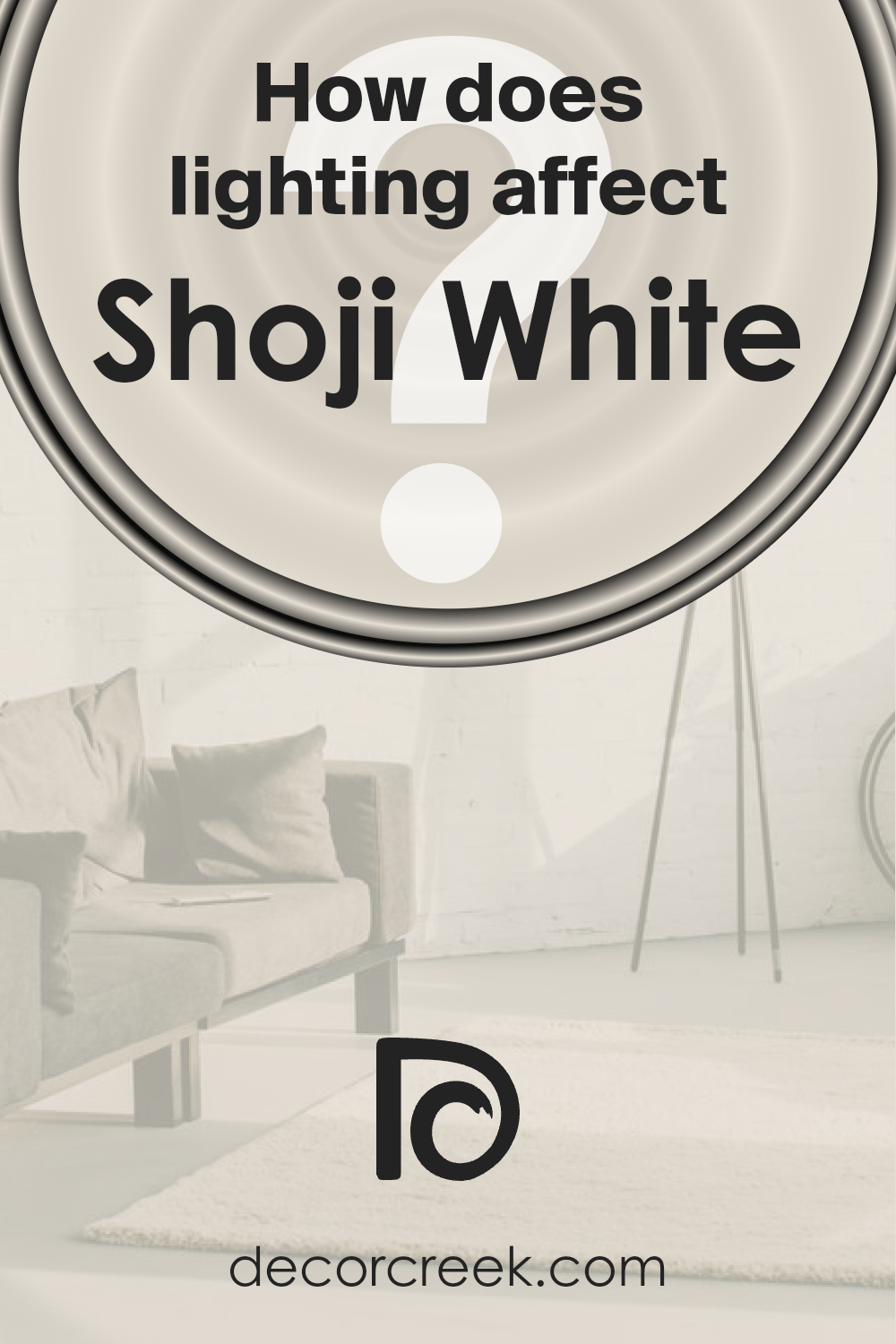
What is the LRV of Shoji White SW 7042 by Sherwin Williams?
LRV stands for Light Reflectance Value, and it’s a measurement that tells us how much light a paint color reflects or absorbs once it’s on your walls.
This value is given on a scale from 0 to 100, where 0 is completely black, absorbing all light, and 100 is pure white, reflecting all light back.
Understanding LRV can help you decide how a color will look in your space under different lighting conditions. It’s particularly useful when you want to make a room feel brighter or cozier depending on how much natural or artificial light it receives.
With an LRV of 74.345, the paint color in question falls into the light-reflective category, meaning it will bounce back a good deal of light into the room.
This makes it a great choice if you’re aiming to give a space a bright and airy feel without going for pure white. Because it reflects quite a bit of light, it can also make a room look more spacious and inviting.
In spaces without a lot of natural light, this color can help in making the area feel less cramped and more open, by effectively using the available light to illuminate the space.
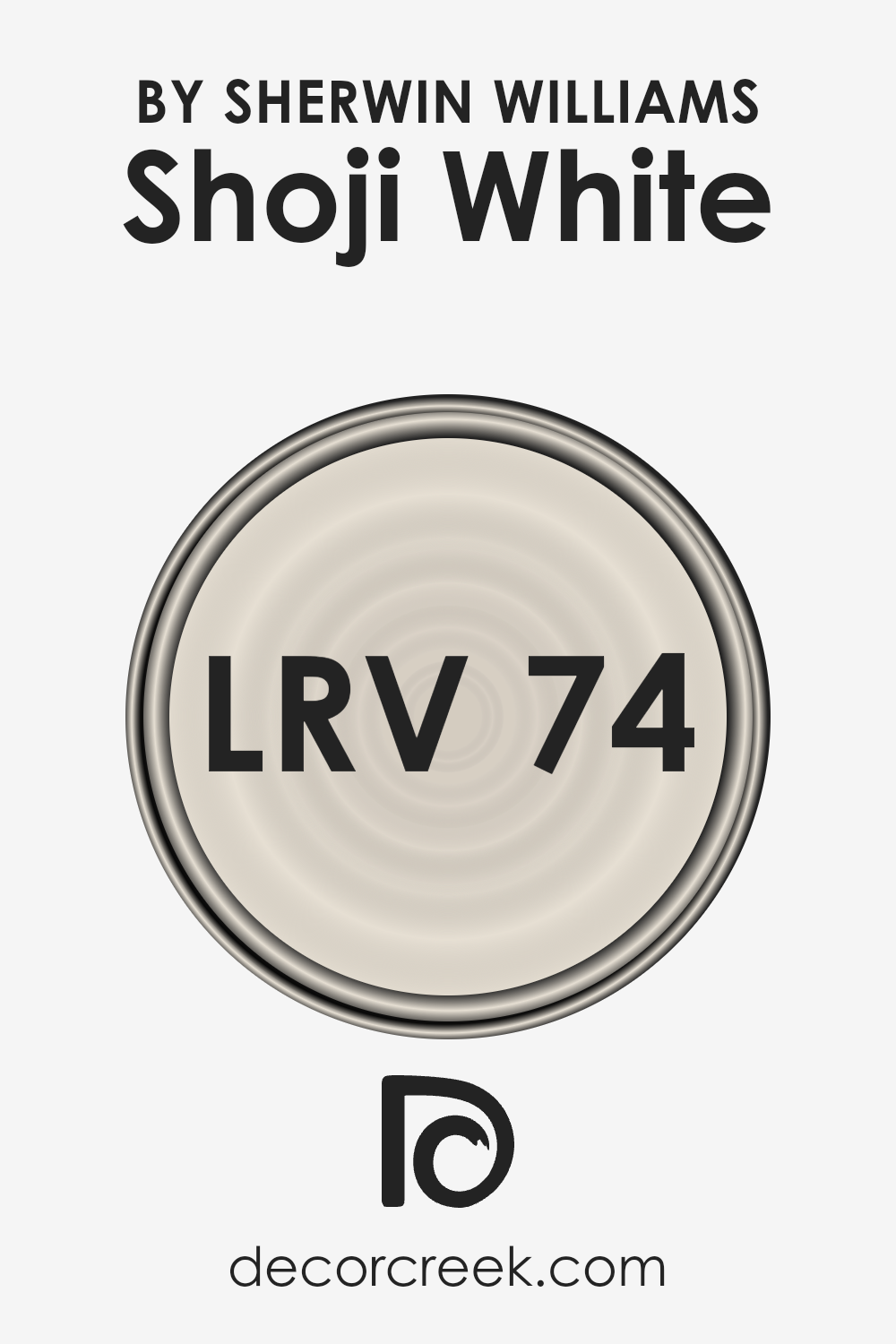
LRV – what does it mean? Read This Before Finding Your Perfect Paint Color
Coordinating Colors of Shoji White SW 7042 by Sherwin Williams
Coordinating colors are those that complement each other and work well together in a space, creating a harmonious look. These are selected to enhance the main color, which in this scenario is Shoji White by Sherwin Williams.
When choosing coordinating colors, it’s important to pick shades that balance the primary color’s warmth or coolness. For Shoji White, a soft and neutral tone, the coordinating colors have been thoughtfully chosen to complement its subtlety and versatility.
These colors can be used for trim, accents, or even as main color schemes in different rooms to maintain a cohesive design throughout the home.
Among the coordinating colors, Perle Noir offers a stark contrast to the softness of Shoji White, presenting a deep, rich black that can add sophistication and depth to any space. It works well for accents or furniture, providing a strong statement.
Pure White, on the other hand, is a crisp and clean shade that pairs beautifully with Shoji White, helping to create a seamless transition between different spaces.
It’s ideal for trim or ceilings, offering a slight contrast while maintaining a light and airy feel. Lastly, Fawn Brindle adds a touch of warmth with its muted gray-brown tone, offering an earthy complement that enhances the natural qualities of Shoji White.
This color works well in cozy spaces, adding depth and warmth without overwhelming the serene base color. Together, these coordinating colors offer a range of options to create beautifully balanced and cohesive spaces around the core hue of Shoji White.
You can see recommended paint colors below:
- SW 9154 Perle Noir (CHECK A SAMPLE)
- SW 7005 Pure White (CHECK A SAMPLE)
- SW 7640 Fawn Brindle (CHECK A SAMPLE)
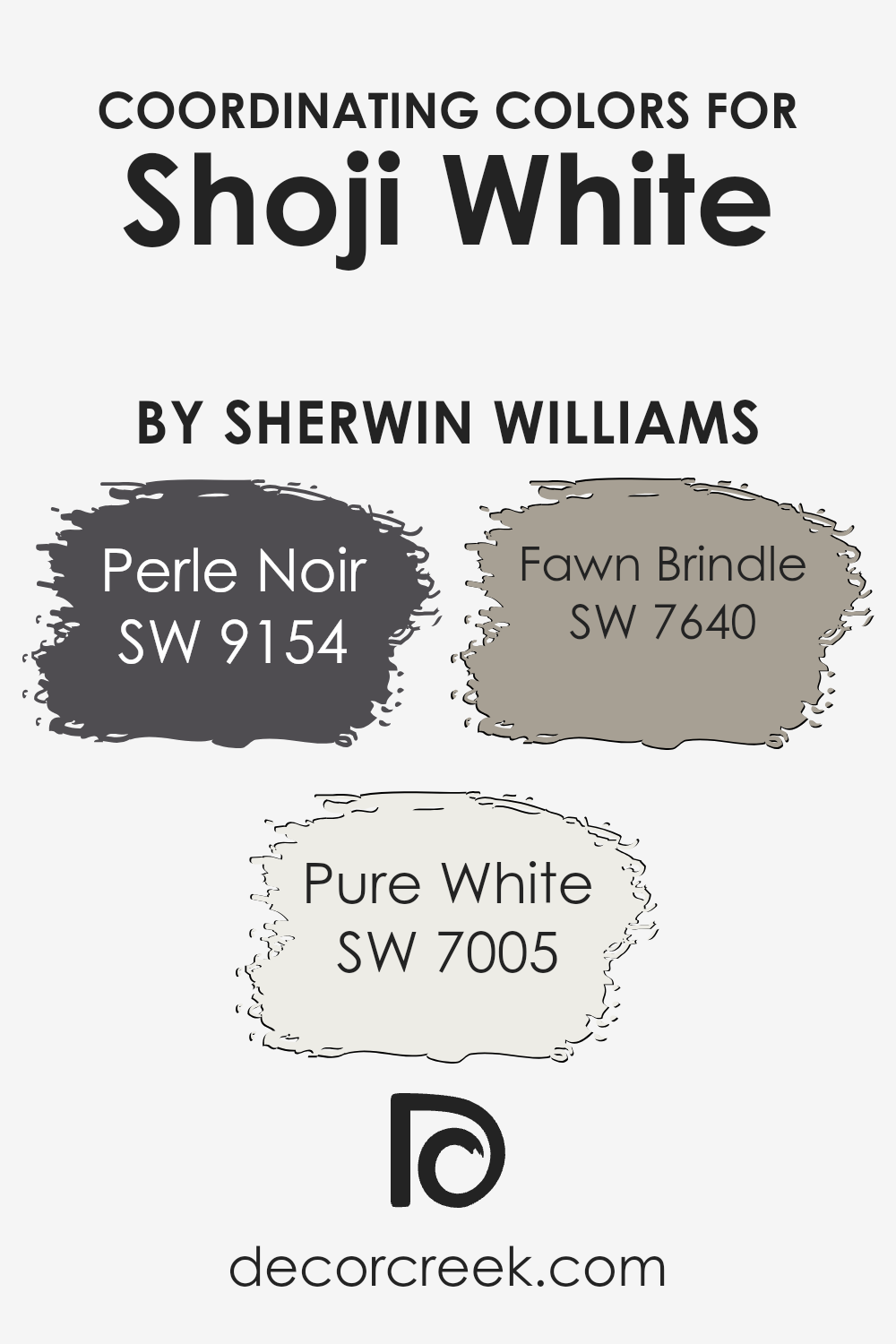
What are the Trim colors of Shoji White SW 7042 by Sherwin Williams?
Trim colors are chosen to complement or contrast with a main wall color, helping to define and accentuate architectural features such as door frames, window frames, skirting boards, and mouldings.
In the case of Shoji White, a popular paint color by Sherwin Williams that offers a warm, inviting tone, selecting the right trim color can significantly enhance the room’s overall aesthetic and ambiance.
The choice of trim color can either subtly blend with the main color for a cohesive look or stand out for a more striking, defined appearance.
This balance of colors contributes to the creation of a desired mood and style within a space, making the selection of an appropriate trim color an important aspect of interior decorating.
Moderate White (SW 6140) is a soft, subdued hue that complements Shoji White by providing a slight contrast while maintaining a harmonious feel within the space.
This trim color is excellent for creating a seamless look, ensuring that the transition between walls and trim is smooth and pleasing to the eye.
On the other hand, Agreeable Gray (SW 7029) offers a bit more contrast against Shoji White, with its gentle gray tones providing a modern and elegant look.
Agreeable Gray as a trim can define space more distinctly, adding depth and character to the overall design.
Each of these colors, while different, serves to enhance the beauty and the warm, welcoming nature of Shoji White, making them perfect choices for trim applications.
You can see recommended paint colors below:
- SW 6140 Moderate White (CHECK A SAMPLE)
- SW 7029 Agreeable Gray (CHECK A SAMPLE)
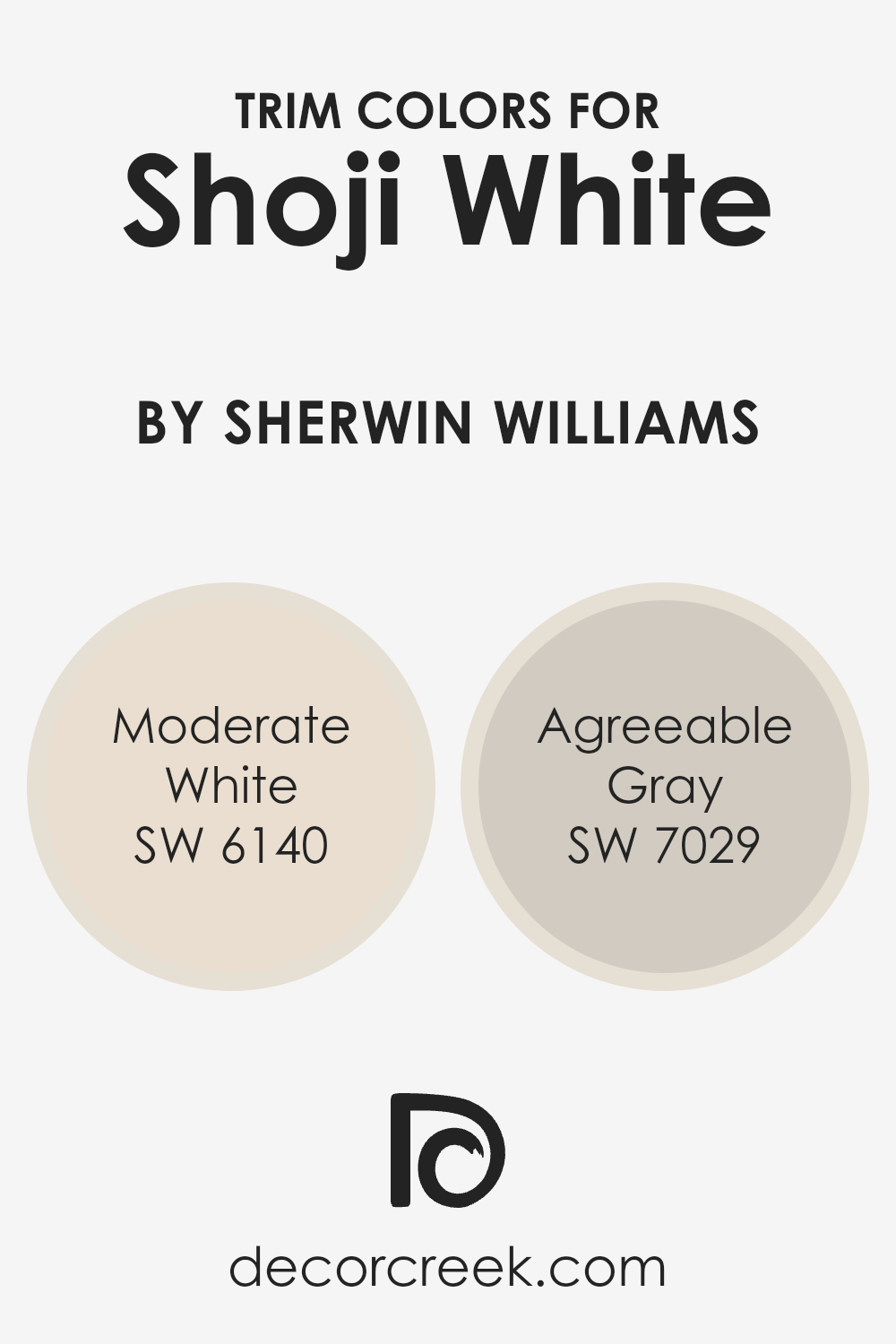
Colors Similar to Shoji White SW 7042 by Sherwin Williams
Similar colors play a crucial role in interior design and decoration because they help create a seamless and cohesive look in a space.
Choosing hues that are similar to Shoji White by Sherwin Williams, such as Aesthetic White, Pearly White, Panda White, White Duck, White Heron, Nacre, Oyster White, Pacer White, Porcelain, and White Sesame, ensures that the various elements of a room harmonize without any one color overpowering the others.
This approach can make a room feel more spacious, unified, and tranquil.
By selecting shades that are closely related, designers can craft a subtle yet inviting ambiance, where the beauty of each color complements the others, enhancing the overall aesthetic appeal without causing visual disruption.
Aesthetic White is a slightly warmer hue that brings a cozy and inviting feel to a space, making it ideal for living areas and bedrooms where comfort is key.
Pearly White, with its soft and luminous quality, can illuminate dark spaces without overwhelming them with brightness. Panda White offers a gentle contrast, slightly deeper than its counterparts, perfect for highlighting architectural details.
White Duck, a muted, off-white with a hint of warmth, works well in spaces that aim for a rustic or earthy feel. White Heron has a clean, crisp quality, making it excellent for modern and minimalist designs.
Nacre, with its pearl-like undertone, adds a touch of elegance to any room. Oyster White, blending cream and gray, offers a sophisticated neutrality. Pacer White is soft and subtle, lending a calm and serene atmosphere.
Porcelain is a classic, true white, providing a fresh and clean backdrop that amplifies natural light. Lastly, White Sesame introduces a hint of beige, creating a cozy, welcoming environment.
Together, these colors can be mixed and matched to achieve a harmonious and beautifully designed space.
You can see recommended paint colors below:
- SW 7035 Aesthetic White (CHECK A SAMPLE)
- SW 7009 Pearly White (CHECK A SAMPLE)
- SW 6147 Panda White (CHECK A SAMPLE)
- SW 7010 White Duck (CHECK A SAMPLE)
- SW 7627 White Heron (CHECK A SAMPLE)
- SW 6154 Nacre (CHECK A SAMPLE)
- SW 7637 Oyster White (CHECK A SAMPLE)
- SW 6098 Pacer White (CHECK A SAMPLE)
- SW 0053 Porcelain (CHECK A SAMPLE)
- SW 9586 White Sesame (CHECK A SAMPLE)

Complimentary Colors for Shoji White SW 7042 Paint Color by Sherwin Williams
Shoji White is a warm, inviting neutral that pairs well with both light and dark colors. For a dramatic touch, Urbane Bronze and Tricorn Black offer bold, rich tones that create stunning accents. If you’re looking for something more natural, Evergreen Fog and Sea Salt bring in gentle green hues, perfect for a soothing atmosphere.
Pure White and Alabaster are great options for brightening up your space, especially for trim or ceilings. Mindful Gray provides a subtle, balanced neutral that complements both light and dark shades. This palette allows you to mix and match for a timeless, elegant look that fits modern and classic homes alike.
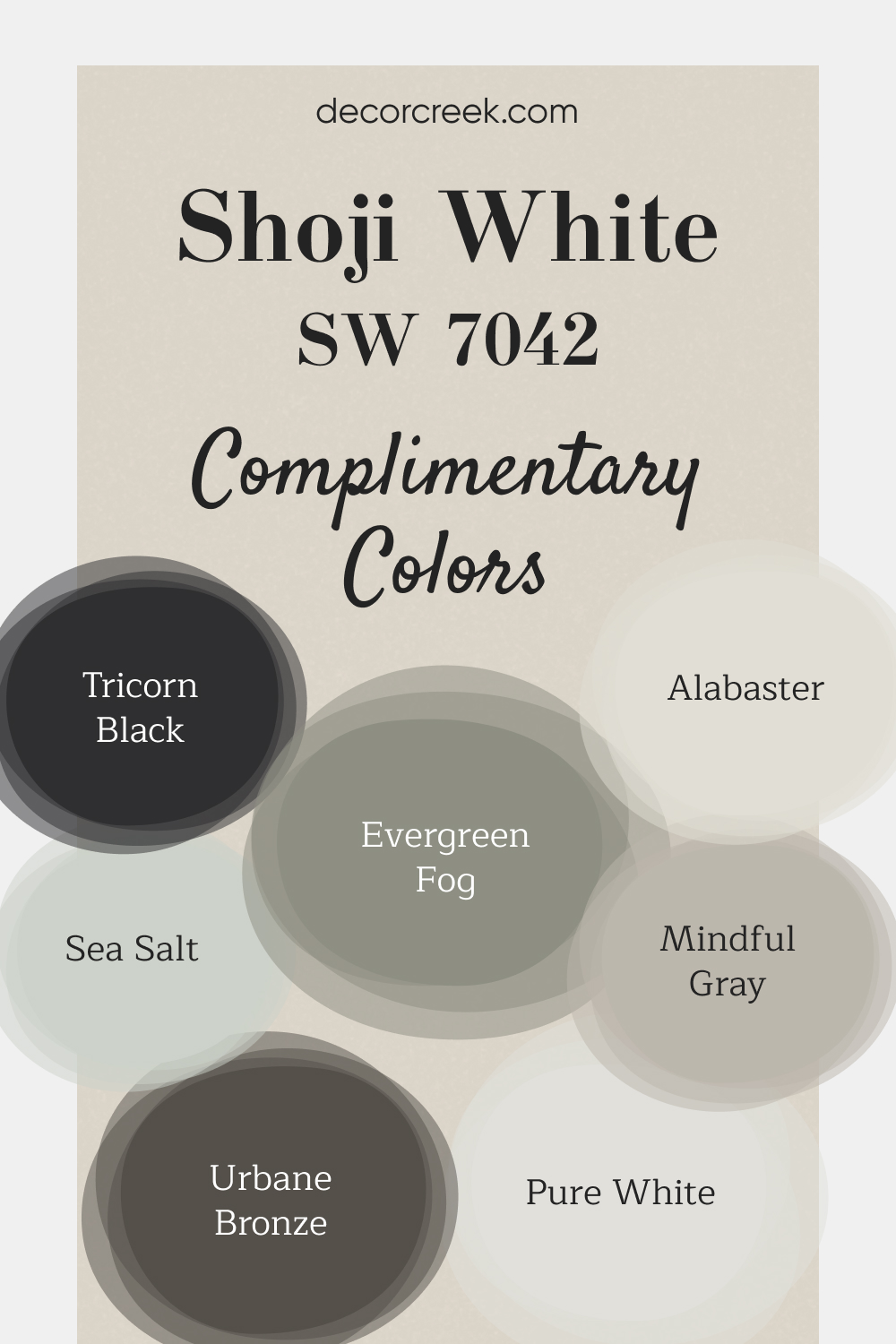
Shoji White SW 7042 by Sherwin Williams Color Palette
Shoji White always feels warm and creamy, with a softness that makes the room feel gentle and calm. Accessible Beige and Natural Linen pair beautifully with it, creating a warm, natural flow. Pure White and Extra White brighten the palette without overwhelming its warmth.
Urbane Bronze and Iron Ore add strength and rich contrast, giving the palette depth. Alabaster softens everything again, keeping the look warm and inviting.
This palette feels natural, warm, and quietly elegant, with Shoji White leading the way.
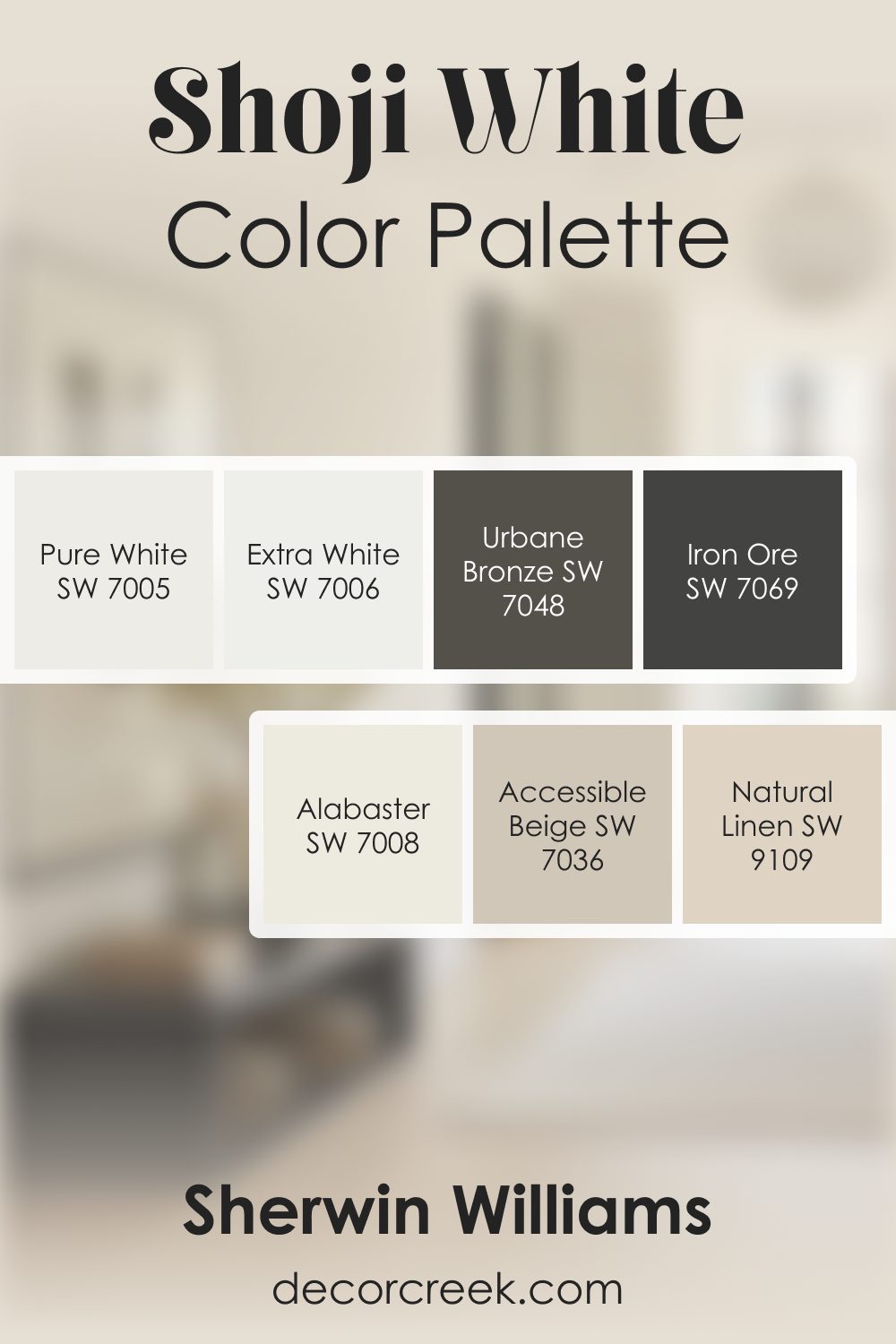
How to Use Shoji White SW 7042 by Sherwin Williams In Your Home?
Shoji White SW 7042 from Sherwin Williams is a warm, welcoming shade of off-white with a hint of beige. This soft and subtle color is versatile, making it a great choice for any room in your home.
Imagine your living room walls painted in Shoji White, creating a cozy atmosphere that’s both bright and inviting. It works well in spaces with lots of natural light, enhancing the room’s overall warmth.
You can also use Shoji White in bedrooms to establish a serene and peaceful environment, perfect for relaxing after a long day. Its neutral tone serves as an excellent backdrop for both bold and soft color accents, meaning you can accessorize with a variety of textures and hues to personalize your space.
In kitchens and bathrooms, Shoji White pairs beautifully with cabinets and countertops, offering a fresh and clean look without feeling sterile. It’s a color that complements wood, metal, and stone, allowing for flexibility in your design choices.
Overall, Shoji White is an adaptable paint color that fits just about any decorating style, from modern to rustic, adding a touch of softness and sophistication to your home.
Shoji White SW 7042 by Sherwin Williams vs White Heron SW 7627 by Sherwin Williams
Shoji White and White Heron, both from Sherwin Williams, are two neutral colors, but they have their own unique characteristics. Shoji White has a warm, welcoming vibe due to its slight beige undertone.
This makes it a great choice for rooms where you want a cozy atmosphere. It’s not just white; it has a creamy touch that adds richness to the space. On the other hand, White Heron is cooler.
It carries a subtle grayish undertone, making it appear more modern and crisp. This color is perfect for spaces that aim for a clean, fresh look.
Think of Shoji White like a warm hug and White Heron as a breath of fresh air. Both are versatile and can blend well with other colors, but they set different moods for a room due to their underlying tones.
Choosing between them depends on whether you prefer a warm, inviting feel or a sleek, contemporary vibe.
You can see recommended paint color below:
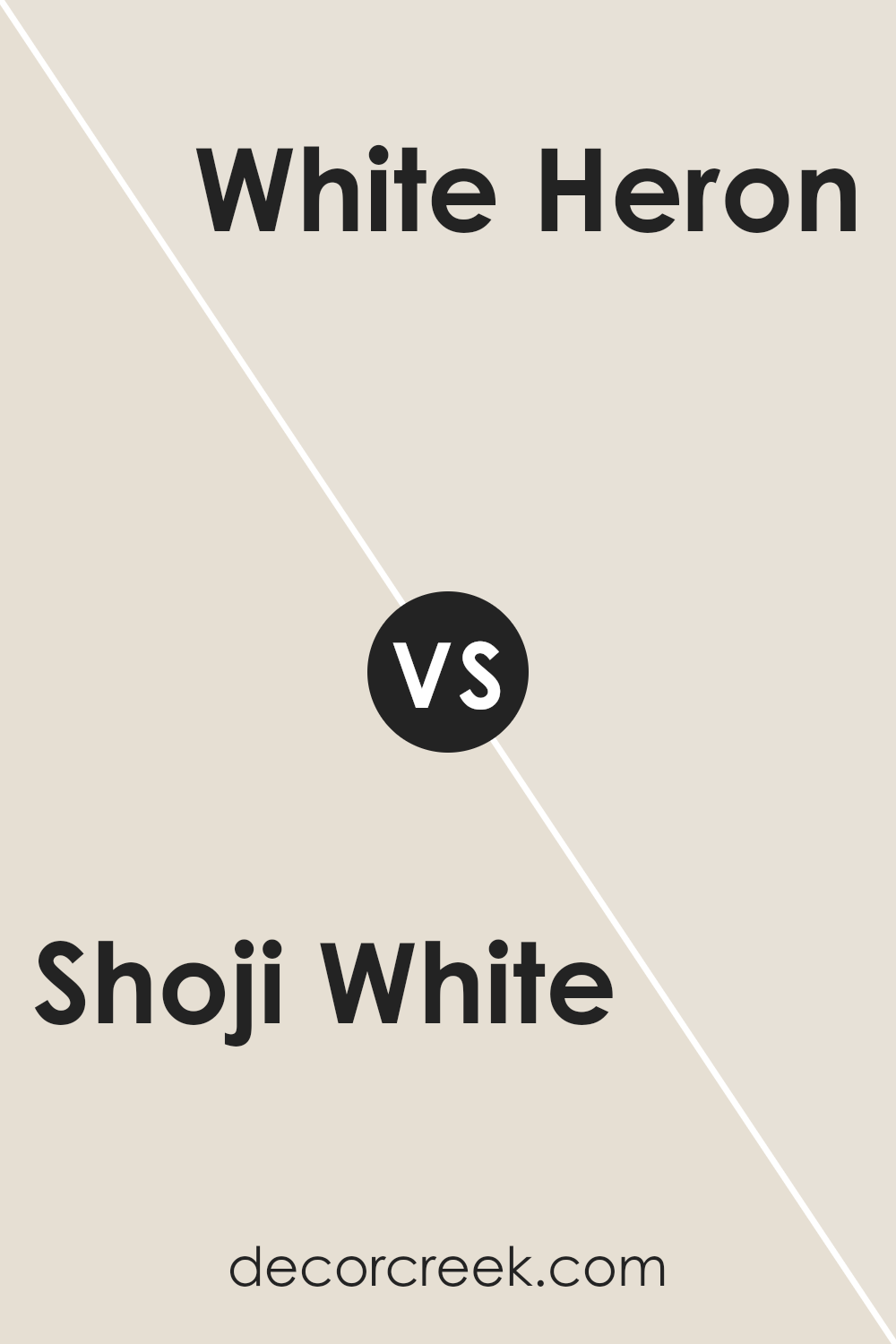
Shoji White SW 7042 by Sherwin Williams vs Porcelain SW 0053 by Sherwin Williams
Shoji White and Porcelain by Sherwin Williams are two popular paint colors that have their own unique characteristics. Shoji White is a soft, warm white with a hint of beige, giving it a cozy and inviting feel.
This color is versatile, making it suitable for a variety of spaces in a home, from living rooms to bedrooms. On the other hand, Porcelain is a cleaner, more classic white with a subtle blue undertone that gives it a crisp and fresh look.
This makes Porcelain an excellent choice for kitchens, bathrooms, or any space that benefits from a bright and airy atmosphere. While Shoji White offers warmth and a touch of coziness, Porcelain presents a pristine, classic backdrop.
Choosing between them depends on the mood and feel you want to create in your space.
You can see recommended paint color below:
- SW 0053 Porcelain (CHECK A SAMPLE)
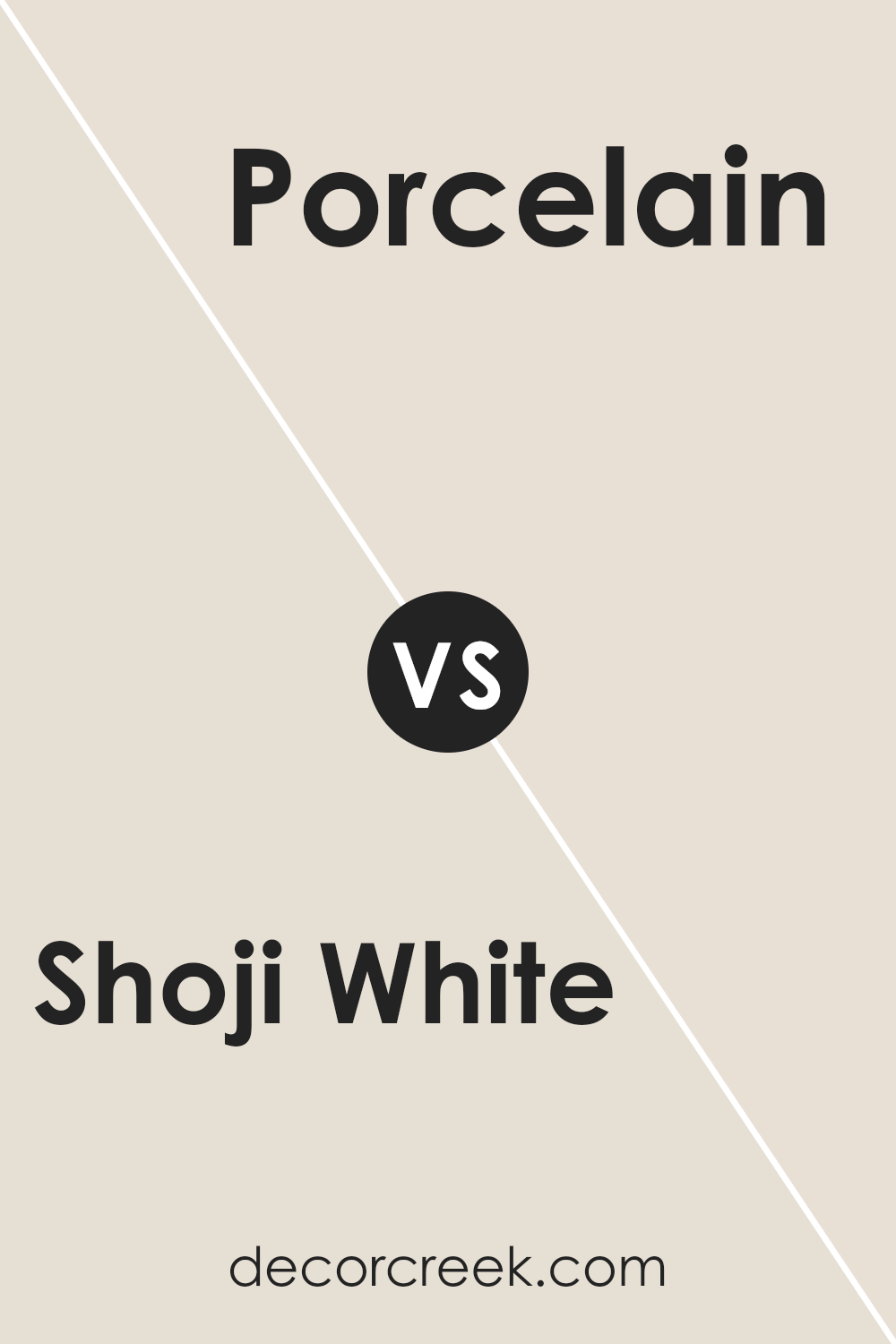
Shoji White SW 7042 by Sherwin Williams vs Aesthetic White SW 7035 by Sherwin Williams
Shoji White and Aesthetic White are two popular shades by Sherwin Williams that share some similarities but have distinct differences that set them apart.
Shoji White is a soft, warm white with a hint of beige, making it a cozy choice for those looking to create a welcoming atmosphere in their home.
It has a slightly creamy feel without being too yellow, striking a beautiful balance that works well in rooms with natural light. On the other hand, Aesthetic White steps a bit away from the warmth of Shoji White, leaning towards a neutral white that borders on a light, soft grey.
This color is perfect for individuals looking for a shade that is closer to true white but still wishes to avoid a stark or cold appearance in their space.
Both colors are versatile and can complement a variety of decor styles and preferences, but the choice between them depends on whether you’re going for a warmer (Shoji White) or a more neutral (Aesthetic White) feel.
You can see recommended paint color below:
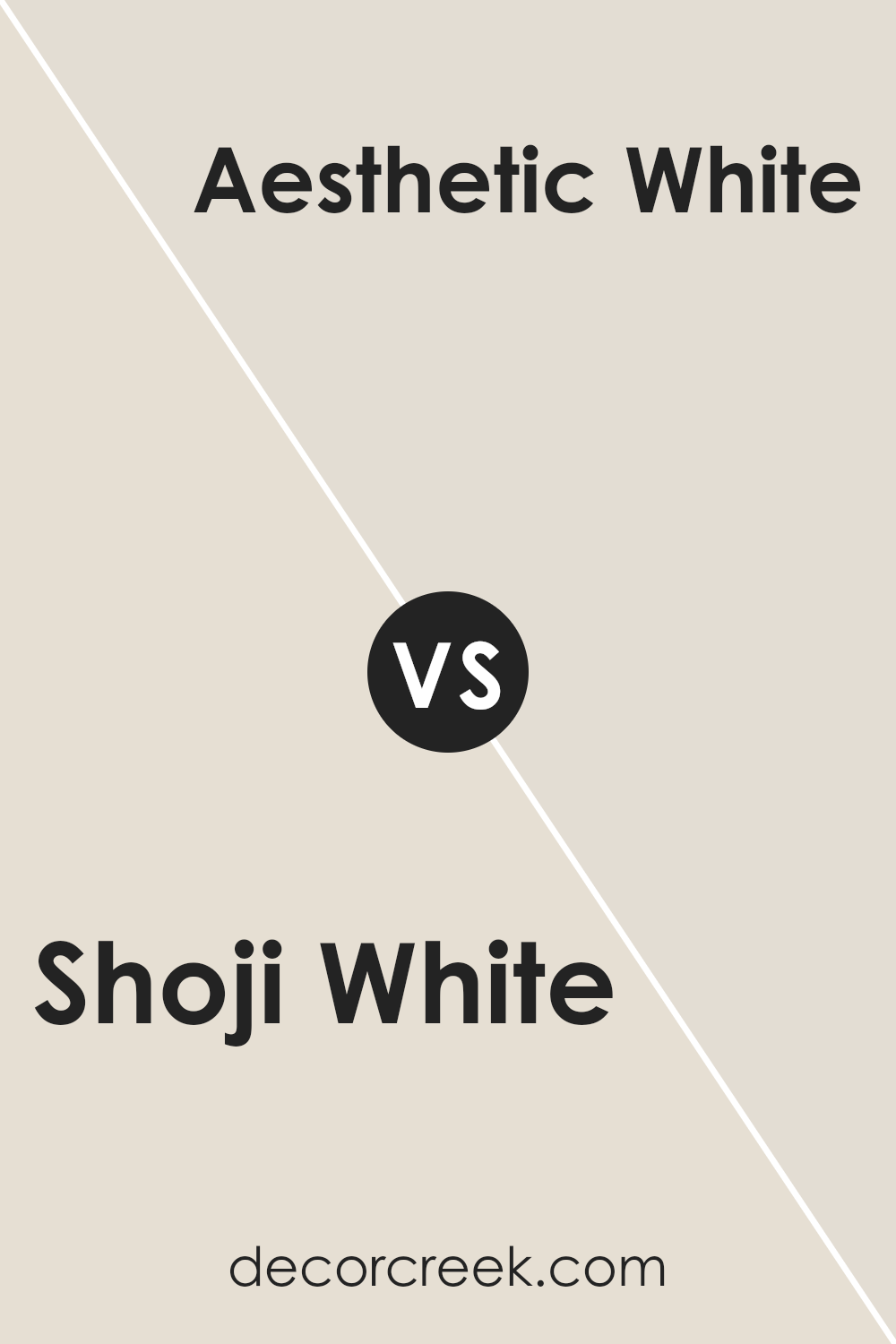
Shoji White SW 7042 by Sherwin Williams vs Pearly White SW 7009 by Sherwin Williams
Shoji White and Pearly White, both by Sherwin Williams, are two beautiful but distinct colors. Shoji White leans more towards a soft, warm beige with a hint of gray.
This gives it a cozy, inviting feel that’s perfect for creating a serene and welcoming ambiance in any room. It’s like the warmth of a sunlit room on a chilly morning, subtle yet distinctly comforting.
On the other hand, Pearly White is lighter and has a more neutral base, which can sometimes appear almost as a soft, creamy off-white. This color brings a fresh, airy feel to spaces, making rooms appear brighter and more spacious.
It’s akin to the soft glow of early morning light, gentle and soothing.
While both colors offer a sense of calm and elegance, Shoji White adds warmth to a room, making it feel more intimate. Pearly White, however, provides a cleaner, more open atmosphere, potentially making it better suited for smaller spaces or rooms that receive less natural light.
Together, they represent the spectrum of warm, neutral paints, each bringing its unique vibe and versatility to interior spaces.
You can see recommended paint color below:
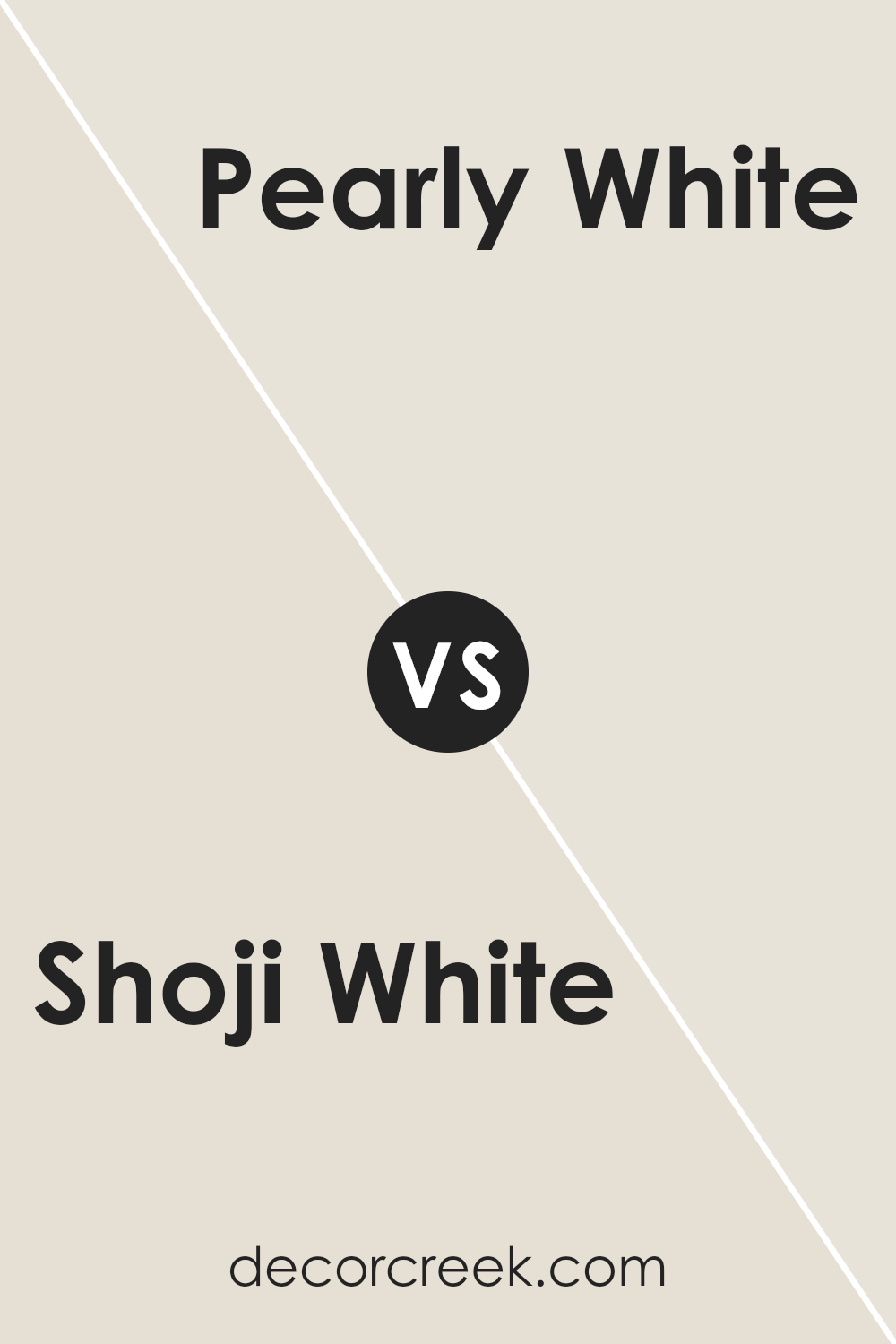
Shoji White SW 7042 by Sherwin Williams vs Nacre SW 6154 by Sherwin Williams
Shoji White and Nacre by Sherwin Williams are two colors that share a calming vibe but have their unique traits. Shoji White is like a soft, warm hug for your walls, giving a gentle, inviting feel.
It’s not stark or cold; rather, it adds a touch of coziness and warmth, making it perfect for almost any space in your home. Think of it as a creamy blanket that wraps your room in comfort.
On the other hand, Nacre takes a step towards elegance with its subtler, more refined appearance. It’s like Shoji White’s sophisticated cousin, offering a hint of luxury without being too flashy.
Nacre has an understated beauty that works wonderfully in spaces where you want a touch of class but still keep things light and airy.
While both colors bring their special touch to a room, Shoji White leans more towards a warm, welcoming feel, whereas Nacre offers a whisper of sophistication and elegance.
Choosing between them depends on the atmosphere you’re aiming to create—cozy and comforting with Shoji White, or refined and chic with Nacre.
You can see recommended paint color below:
- SW 6154 Nacre (CHECK A SAMPLE)

Shoji White SW 7042 by Sherwin Williams vs White Sesame SW 9586 by Sherwin Williams
Shoji White and White Sesame by Sherwin Williams are two popular shades with distinct vibes. Shoji White has a warm, soft appearance, making spaces feel cozy and inviting.
It’s perfect if you’re looking for a white that’s not too stark, blending beautifully in rooms with plenty of natural light or complementing warm-toned decors.
On the other hand, White Sesame is slightly cooler and offers a more neutral base. This makes it versatile for various settings, acting as a subtle backdrop that allows other colors to stand out.
It’s a go-to for creating a sleek, modern look without feeling too cold or impersonal.
When comparing them, consider the mood you’re aiming for: Shoji White leans towards a warm, welcoming feel, while White Sesame serves as a crisp, clean canvas adaptable to any style.
You can see recommended paint color below:
- SW 9586 White Sesame (CHECK A SAMPLE)
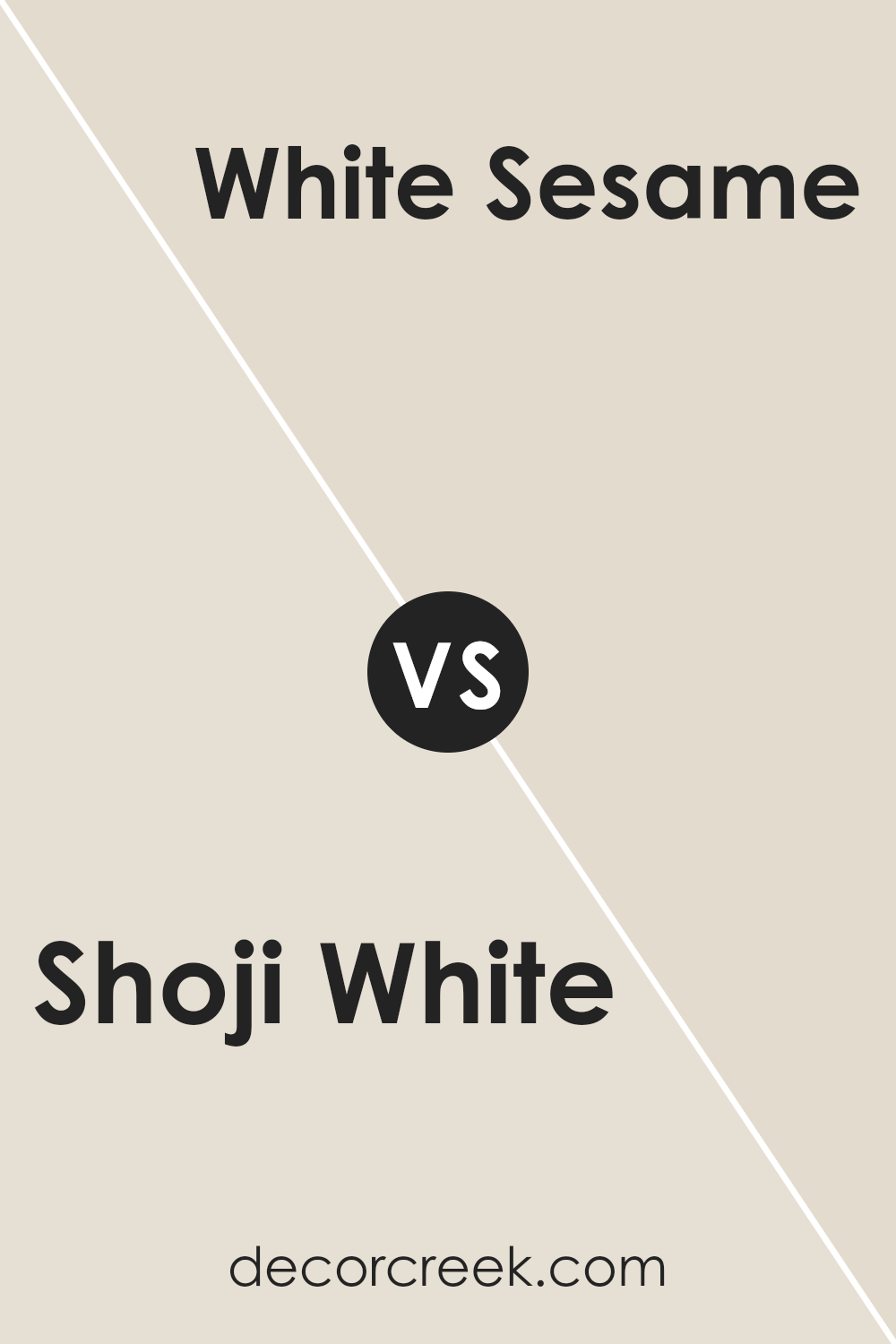
Shoji White SW 7042 by Sherwin Williams vs Panda White SW 6147 by Sherwin Williams
Shoji White and Panda White, both from Sherwin Williams, offer subtle differences in the white paint spectrum. Shoji White leans towards a warm, inviting neutral with a soft, beige undertone.
It’s a versatile color that can make spaces feel cozy yet bright. On the other hand, Panda White steps in with a slightly cooler vibe. Although still warm, it carries a hint of gray, making it a bit more nuanced than Shoji White.
The gray undertone adds a touch of sophistication and can help other colors in the room pop.
While both colors bring their own unique feel, Shoji White tends to create a warmer, more enveloping atmosphere, making it ideal for living spaces aiming for a snug, welcoming vibe.
Panda White, with its cooler, subtly complex character, is perfect for spaces needing a crisp, clean look with a touch of warmth.
Each color offers a beautiful backdrop for different design styles, making the choice between them a matter of personal preference and the specific mood or theme one aims to achieve.
You can see recommended paint color below:
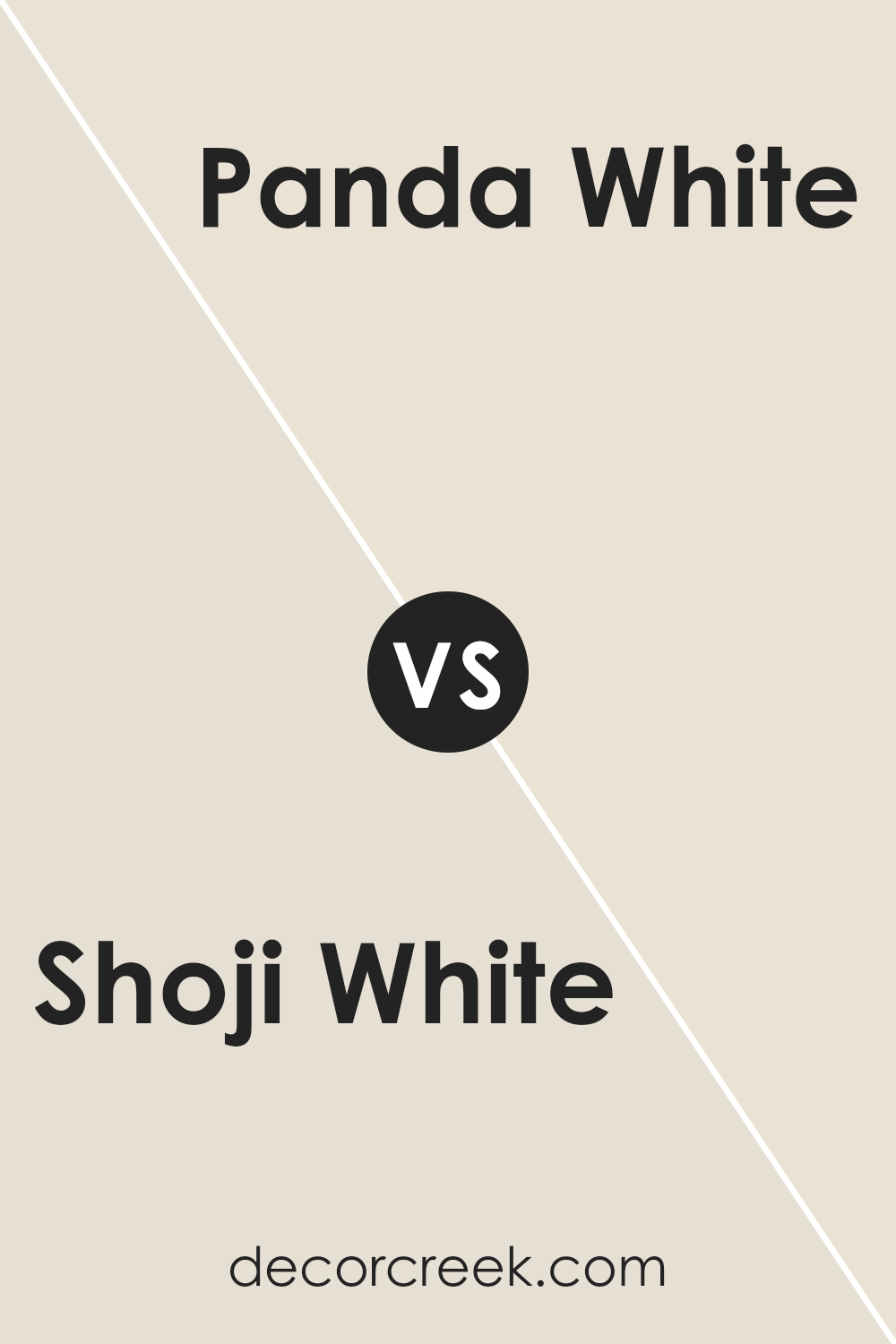
Shoji White SW 7042 by Sherwin Williams vs Pacer White SW 6098 by Sherwin Williams
Shoji White and Pacer White, both from Sherwin Williams, offer subtle yet distinct tones for those looking to add a touch of elegance and warmth to their spaces.
Shoji White leans towards a warm, soft beige with a hint of greyness that makes it incredibly versatile for any space, creating a cozy yet bright atmosphere.
Its understated elegance allows it to adapt seamlessly, whether in a sun-drenched living room or a dimly lit hallway, ensuring a welcoming vibe throughout.
On the other hand, Pacer White brings a slightly creamier feel to the table, warming up spaces with its inviting hue. This color has a buttery undertone that adds depth and coziness, making rooms feel more intimate and snug.
It works wonders in spaces that aim for a soft, yet vibrant feel, standing out more distinctly against trim and accent colors compared to its Shoji counterpart.
In summary, while Shoji White offers a crisp, versatile backdrop suitable for any room, Pacer White adds a layer of warmth and intimacy, making it ideal for those looking to create a cozy retreat.
You can see recommended paint color below:
- SW 6098 Pacer White (CHECK A SAMPLE)
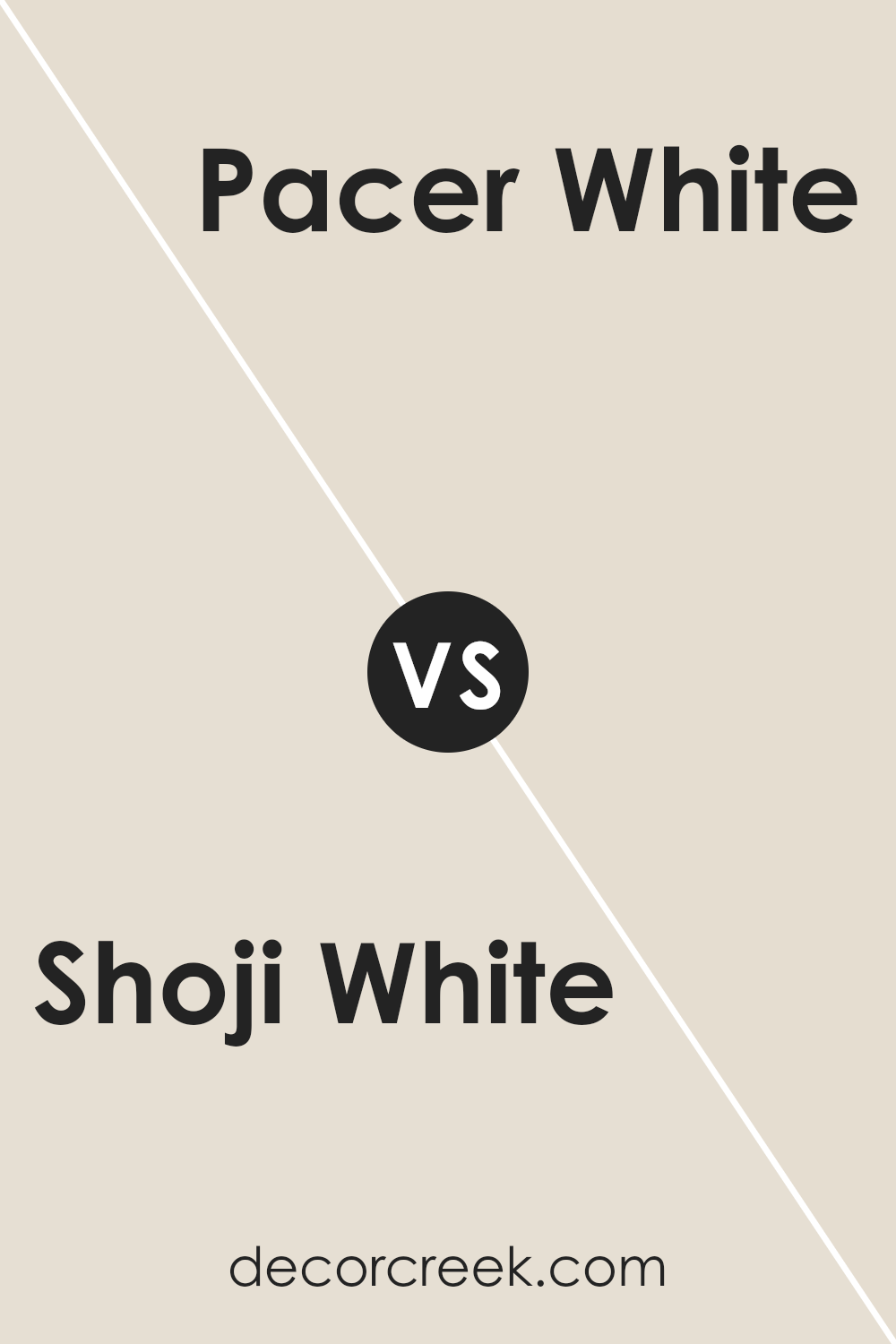
Shoji White SW 7042 by Sherwin Williams vs White Duck SW 7010 by Sherwin Williams
Shoji White and White Duck, both by Sherwin Williams, are two popular shades often picked for their subtle and soothing presence.
Shoji White is a warm, soft white with a welcoming feel, perfect for creating a cozy yet bright atmosphere. It carries a hint of greige, which makes it versatile for any space, blending well with various decor styles and colors.
On the other hand, White Duck is a unique shade categorized under off-white. It has a slightly more beige tone compared to Shoji White, offering a more grounded and earthy vibe.
This color is great for those who want a hint of warmth in their spaces without going too creamy or yellow. It’s especially beautiful in rooms with a lot of natural light, as it can shift and play with the changing sunlight throughout the day.
Both colors are excellent choices for anyone looking to refresh their space with a subtle nod to modern elegance. However, your preference might depend on the specific mood or atmosphere you’re aiming to achieve.
Shoji White leans more towards gentle brightness, while White Duck offers a touch of earthiness.
You can see recommended paint color below:
- SW 7010 White Duck (CHECK A SAMPLE)
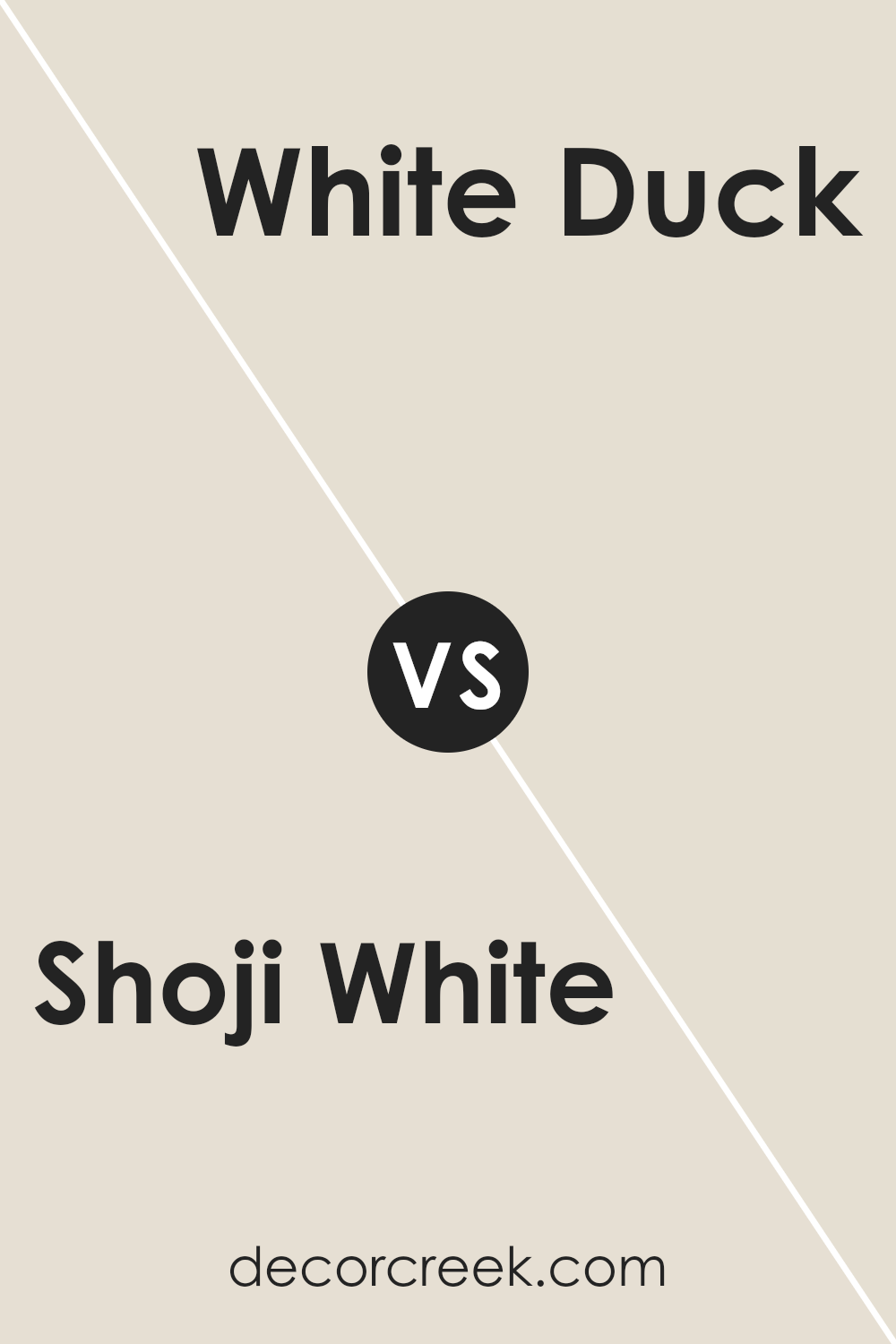
Shoji White SW 7042 by Sherwin Williams vs Oyster White SW 7637 by Sherwin Williams
Shoji White and Oyster White are two popular paint colors by Sherwin Williams, both loved for their subtle charm, but they bring their own unique vibes to a space.
Imagine Shoji White as a soft, warm white with a hint of beige. It’s like the cozy feel of a well-lit room on a sunny day, making it inviting and comfortable.
On the other hand, Oyster White leans a bit more towards a greige tone, mixing gray and beige. This gives it a slightly cooler appearance but still very welcoming and versatile.
If you’re trying to decide between the two for a room, think about the mood you want to create. For a warmer, cozier atmosphere, Shoji White is your go-to.
It’s great for spaces where you want to relax and feel at home. For rooms that get a lot of light or for a more modern, sleek look, Oyster White might be the better choice.
It’s excellent for adding subtle depth while keeping the space light and airy. Both colors work well in various settings, so it really comes down to personal preference and the specific feel you’re aiming for in your space.
You can see recommended paint color below:
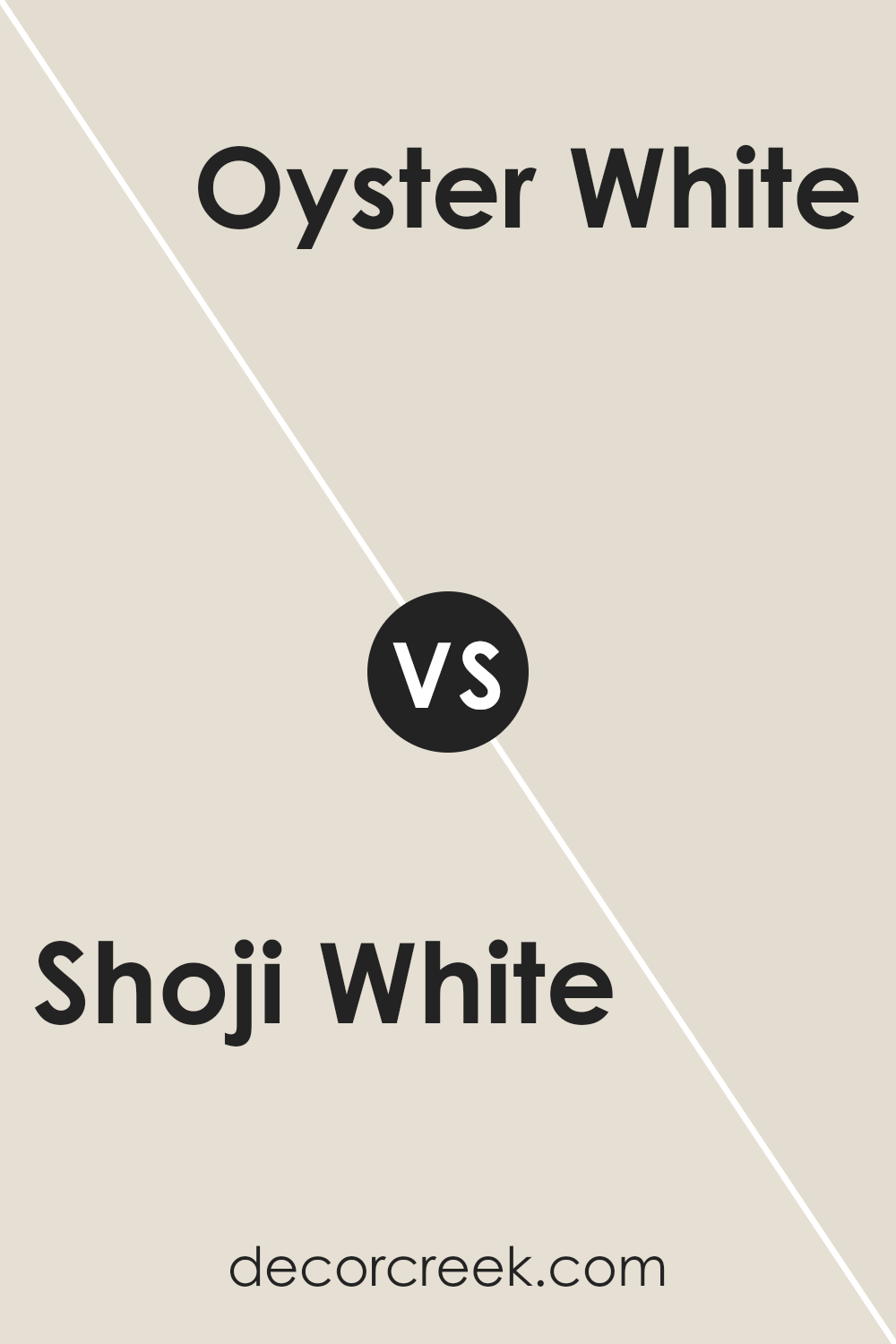
Conclusion
Shoji White by Sherwin Williams stands out for its understated elegance, making it a popular choice for homeowners and designers looking to create a serene and welcoming space.
This color manages to strike a perfect balance between warmth and brightness, making it a versatile option for any room. Its ability to blend seamlessly with different styles and decors, from modern to traditional, adds to its widespread appeal.
The shade acts as an excellent backdrop for both bold and subtle design choices, proving that simplicity can indeed hold a profound impact on interior aesthetics.
Furthermore, Shoji White is praised for its adaptability in varied lighting conditions, showcasing subtle shifts that contribute to its unique charm.
Whether used in large open spaces or cozy corners, it maintains its beauty, enhancing the overall feel of the home. This characteristic underlines the color’s potential to create inviting and comfortable environments, further demonstrating why it’s favored by so many.
In conclusion, Shoji White by Sherwin Williams is more than just a paint color; it’s a design tool capable of transforming spaces into places of tranquility and warmth.
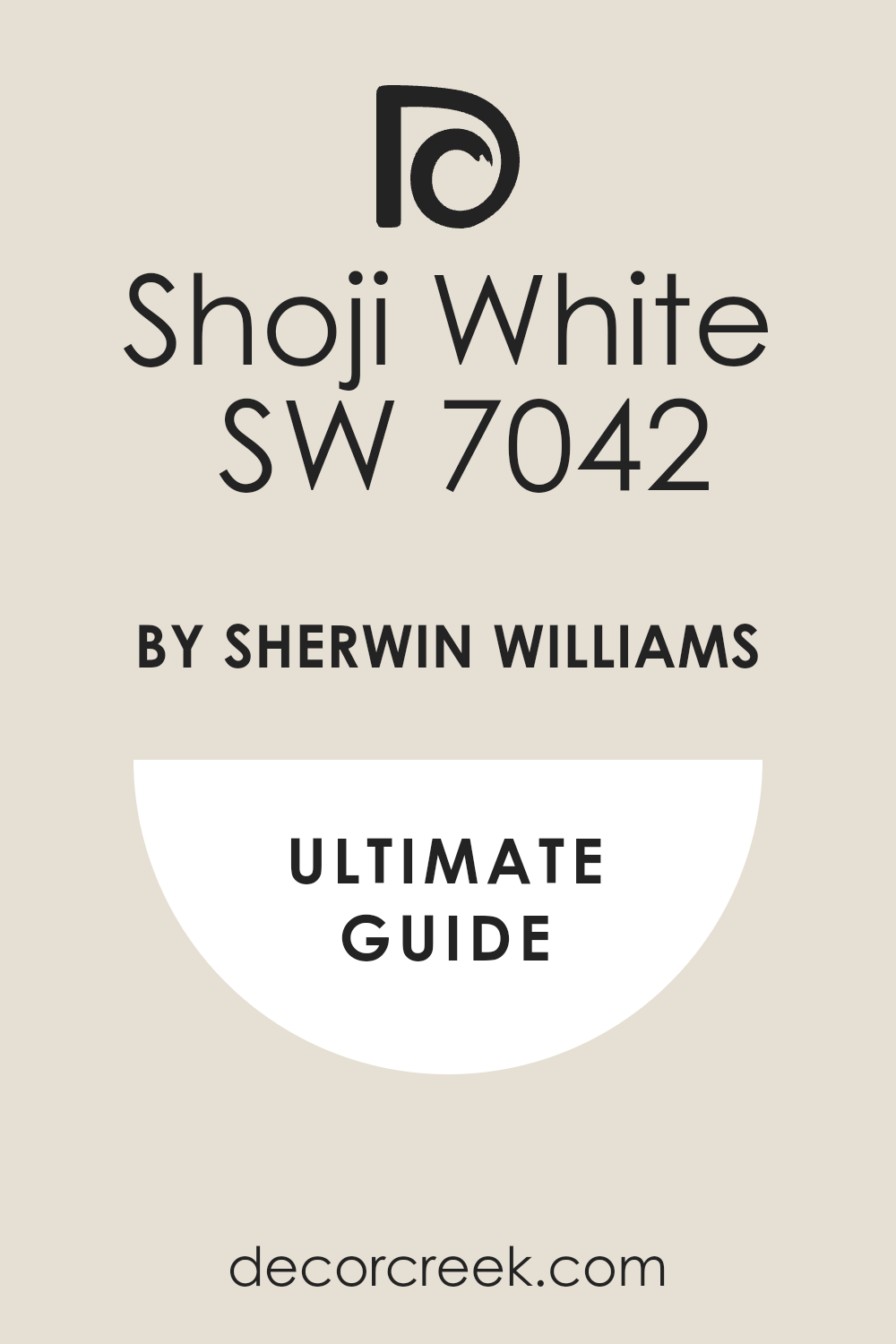
Ever wished paint sampling was as easy as sticking a sticker? Guess what? Now it is! Discover Samplize's unique Peel & Stick samples.
Get paint samples
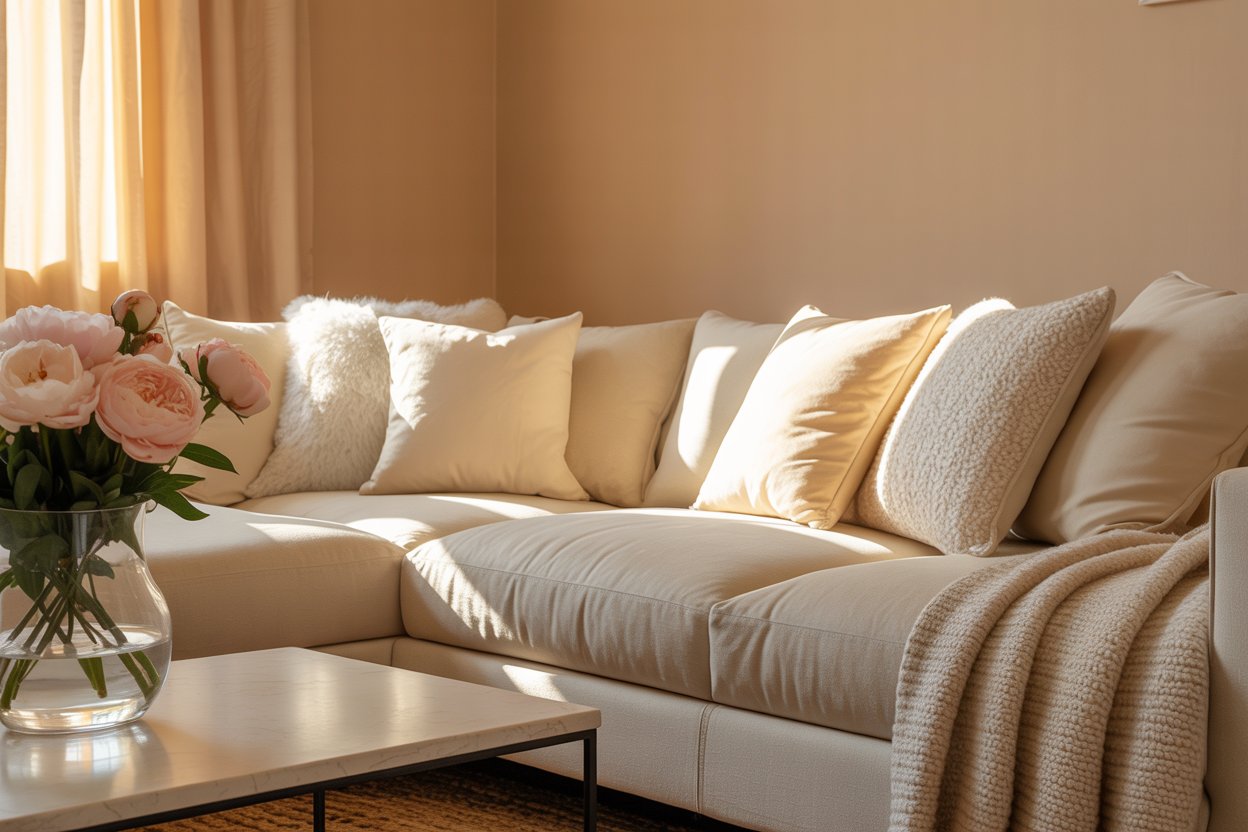
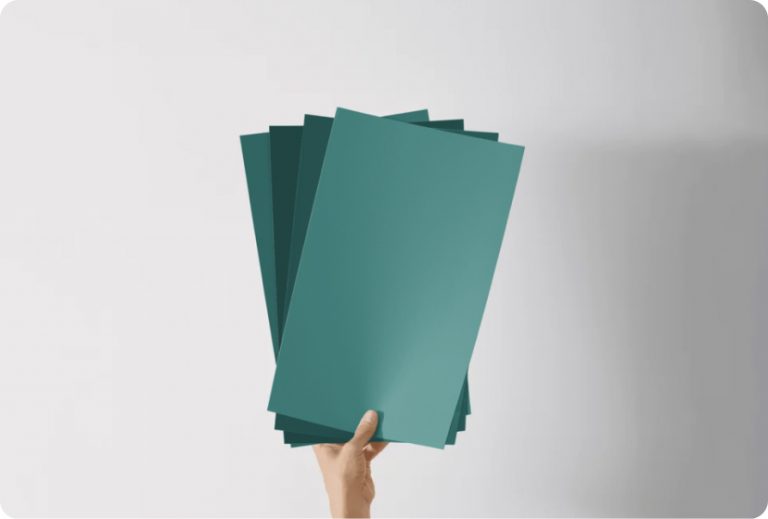






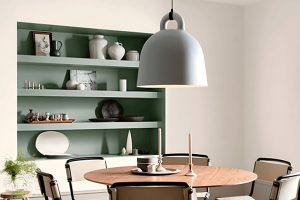

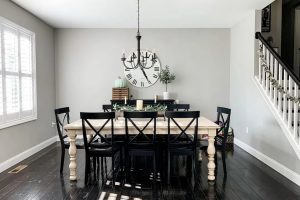

What a great article. Decided to paint kitchen cabinets this gorgeous color. As this is a new build, do you think it would be OK to paint all the walls Greek villa, including the doors, trim and ceilings in different sheans? Lrv difference is only 10 points between the two. Looking forward to your thoughts.
That sounds like a beautiful choice! Greek Villa is a versatile, soft white that would create a lovely, cohesive look throughout your kitchen.
Painting the walls, trim, doors, and ceilings in different sheens is a great idea—it adds subtle contrast while keeping everything unified. Just be sure to use a higher sheen for the trim and doors (like semi-gloss) for durability and a bit of shine, while a matte or eggshell finish would work nicely on the walls and ceiling.
The LRV difference being only 10 points is totally fine, so you’re on the right track!
Hi!! Painting cabinets Shoji. Need help with a warm light neutral for walls and trim. Please help!!